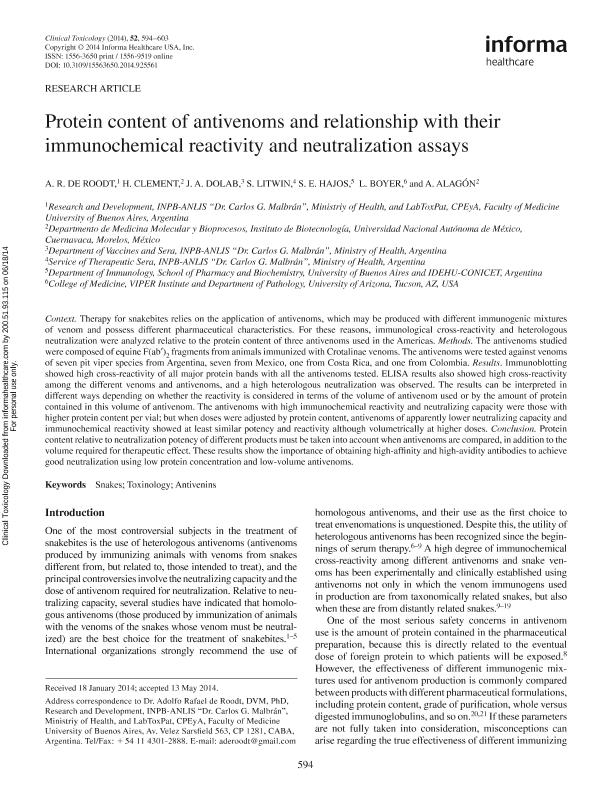Artículo
Protein content of antivenoms and relationship with their immunochemical reactivity and neutralization assays
de Roodt, Adolfo Rafael; Clement, H.; Dolab, Juan Gabriel ; Litwin, Silvana; Hajos, Silvia Elvira
; Litwin, Silvana; Hajos, Silvia Elvira ; Boyer, L.; Alagón, A.
; Boyer, L.; Alagón, A.
 ; Litwin, Silvana; Hajos, Silvia Elvira
; Litwin, Silvana; Hajos, Silvia Elvira ; Boyer, L.; Alagón, A.
; Boyer, L.; Alagón, A.
Fecha de publicación:
07/2014
Editorial:
Taylor & Francis
Revista:
Clinical Toxicology
ISSN:
1556-3650
e-ISSN:
1556-9519
Idioma:
Inglés
Tipo de recurso:
Artículo publicado
Clasificación temática:
Resumen
CONTEXT: Therapy for snakebites relies on the application of antivenoms, which may be produced with different immunogenic mixtures of venom and possess different pharmaceutical characteristics. For these reasons, immunological cross-reactivity and heterologous neutralization were analyzed relative to the protein content of three antivenoms used in the Americas.
METHODS: The antivenoms studied were composed of equine F(ab')2 fragments from animals immunized with Crotalinae venoms. The antivenoms were tested against venoms of seven pit viper species from Argentina, seven from Mexico, one from Costa Rica, and one from Colombia.
RESULTS: Immunoblotting showed high cross-reactivity of all major protein bands with all the antivenoms tested. ELISA results also showed high cross-reactivity among the different venoms and antivenoms, and a high heterologous neutralization was observed. The results can be interpreted in different ways depending on whether the reactivity is considered in terms of the volume of antivenom used or by the amount of protein contained in this volume of antivenom. The antivenoms with high immunochemical reactivity and neutralizing capacity were those with higher protein content per vial; but when doses were adjusted by protein content, antivenoms of apparently lower neutralizing capacity and immunochemical reactivity showed at least similar potency and reactivity although volumetrically at higher doses.
CONCLUSION: Protein content relative to neutralization potency of different products must be taken into account when antivenoms are compared, in addition to the volume required for therapeutic effect. These results show the importance of obtaining high-affinity and high-avidity antibodies to achieve good neutralization using low protein concentration and low-volume antivenoms.
Archivos asociados
Licencia
Identificadores
Colecciones
Articulos(IDEHU)
Articulos de INST.DE EST.DE LA INMUNIDAD HUMORAL PROF.R.A.MARGNI
Articulos de INST.DE EST.DE LA INMUNIDAD HUMORAL PROF.R.A.MARGNI
Citación
Alagón, A.; Boyer, L.; Hajos, Silvia Elvira; Litwin, Silvana; Dolab, Juan Gabriel; Clement, H.; et al.; Protein content of antivenoms and relationship with their immunochemical reactivity and neutralization assays; Taylor & Francis; Clinical Toxicology; 52; 6; 7-2014; 594-603
Compartir
Altmétricas



